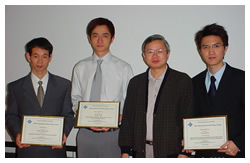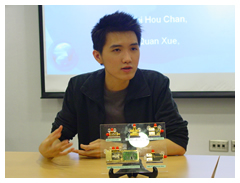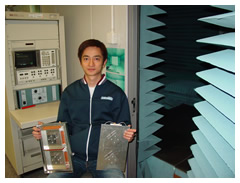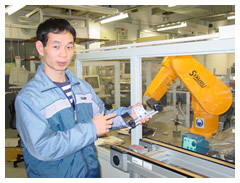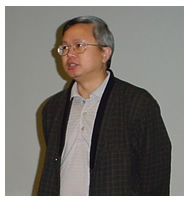Budding engineers clinch IEEE paper contest awards
Grace Ho
Six outstanding engineering students, three each from the City University of Hong Kong and the Chinese University of Hong Kong, shared the honours at the 2002 IEEE Hong Kong Student Paper Contest awards. The awardees presented their winning papers and achievements of their innovative research projects at the award presentation ceremony held on 22 February at the Hong Kong Polytechnic University.
The second prize in the Postgraduate Section went to Mr Wong, a 2002 MPhil graduate who now works as a Research Assistant in the Department of Electronic Engineering's Wireless Communication Research Centre. By using "dual-feed" technology, Mr Wong's research on "Dual-Polarized PCS Base Station Antennas and Array" aims to build up a wideband dual-polarized patch antenna and arrays which can achieve more than 30dB isolation. He also investigates symmetrical radiation patterns at both ports with low back-lobe radiation. Mr Wong has successfully reduced coupling between the array elements by cutting slots in the ground plane and the surrounding metallic walls, while at the same time suppressing back-lobe radiation. His research results will be useful in wireless communication systems as base station antennas.
A paper on "Perception Planning for Model-based Robot Vision" won the third prize in the Postgraduate section for Mr Chen, a PhD student in the Department of Manufacturing Engineering and Engineering Management. He developed a "Viewpoint Planner" system to generate a sensor placement plan for model-based robot vision. The system includes several functions, such as 3D animation of object geometry, sensor specification, initialization of viewpoint number and their distribution, viewpoint evolution, computation of the shortest path, scene simulation from specific viewpoint, and parameter amendment. Mr Chen demonstrated the effectiveness of his proposed method for automatic sensor placement and revealed related experiment results conducted on a real robot vision system. The system can be applied in product quality inspection in industry.
Congratulating the winners, Dr Ngan commended them on their stimulating presentations. "I am delighted to see such great potential in our young scientists' research work. I encourage all of you to expand your horizons to compete with your peers from around the world and to equip yourselves to meet challenges of the knowledge-based society. The IEEE Student Branch will be an ideal platform to help and support you to realize your potentials for the benefits of professional development and society's advancement."
This year's contest received a total of 40 entries: 17 for the undergraduate and 23 for the postgraduate section, respectively. Each paper was assessed by two experts in the specific area of study. The six winning papers, three from each section, will be sponsored by the IEEE Hong Kong Student Branch to join the Region 10 Student Congress 2003.
CityU has a distinguished association with the IEEE. In November 2002, three eminent CityU scientists were elected fellows of the IEEE, bringing our total to eight fellows to date.
